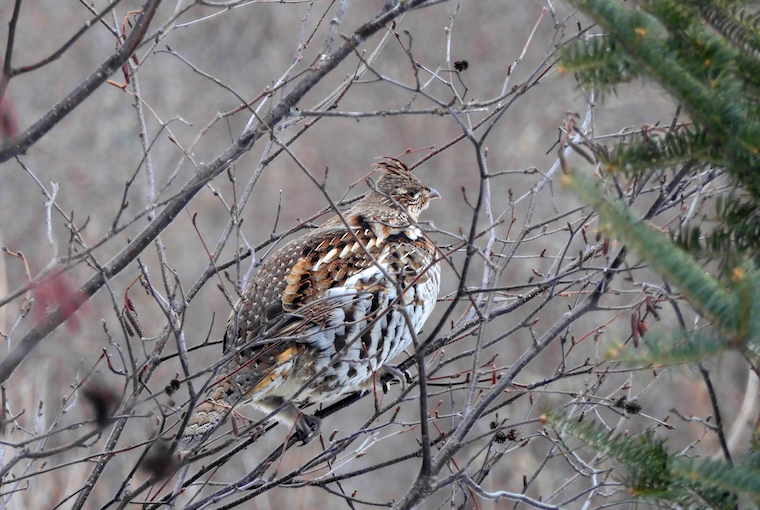
There’s something incredibly peaceful about hunting in early winter. The woods are calm and quiet. Fresh, clean snow blankets the ground. As hunting winds down for the year, this unique season offers a chance for one last adventure: hunting late-season grouse in a winter wonderland. With no pressure to fill a tag, this experience is almost always worth having, and while late-season grouse can be a lot of work, it’s also rewarding and satisfying. I find getting one bird in the powder is more memorable and exciting than a limit of five in early October.
Once the snow flies, grouse habits and behaviours change, making finding them a little more challenging. Generous seasons, however, provide plenty of opportunity to hunt grouse in the snow and extend your hunting season.
Snow habits
Grouse behaviour changes as snow accumulates. No longer can hunters drive or walk bush roads and expect to find birds happily picking gravel and eating greens along the edge of a road or trail. Snow cover forces grouse to move elsewhere for food. They walk around less and fly more often from roost to feeding areas. They still walk short distances, but roost near a food source. Energy conservation is key, so they prefer food and cover close together. Grouse can often be seen roosting in trees, puffed up to help them stay warm, or eating buds high in deciduous trees like birch and aspen.
You’ll still find them slowly picking their way along road edges at times, but these areas don’t have the same draw they did in the fall. Once the snow is deep enough to fully cover roads, these areas lose their appeal.
My dad, retired wildlife biologist Ted Armstrong — who ignited my passion for the outdoors — shared insight from his career alongside a lifetime of bird watching and hunting.
“Budding” behaviour increases considerably, particularly for ruffed grouse, as winter approaches, he said. Generally, grouse are less active and feed less frequently, spending more time hunkered down avoiding predators and reducing exposure to the cold. They become more efficient, usually eating once or twice a day close to first and last light for shorter periods of time.
“One of the best places to find grouse when the snow has come, is when they are feeding on the buds of deciduous trees,” Armstrong Sr. said. “Hunters have to completely change their search image and start looking up high for grouse.”
With no leaves on branches, grouse can be easy to spot. They prefer mixed deciduous and coniferous forests, offering both cover and feed. Although they may be seen feeding in younger deciduous trees, they are most often found around the better cover of mature forest. Best spots are in wooded areas along creeks, rivers, and the edges of cutovers.
Food sources
Asked about the preferred winter food sources of grouse, Armstrong Sr. said they will eat a variety of different buds and catkins, including aspen (poplar), beaked hazelnut, birch, and willow. Finding areas with these mixed in with or close to heavier cover would indicate an ideal grouse-hunting area.
Grouse guns
Firearm choice for this kind of adventure ultimately comes down to personal preference. For more, two main options are a rimfire (like a .22 or .17 HMR) or shotgun. For this type of hunt, mobility is key.
While it would work, toting around your standard pump-action 12-gauge can become a little cumbersome, and unnecessary. Something lighter like a 20 or 28 gauge, or a .410, are good options. The 28-gauge shotgun has become my grouse go-to. It’s the perfect mix of portability, power, and payload. Sitting between a 20 gauge and .410, it takes the best features of each and combines them in a perfect little grouse gun.
For rimfires, a standard .22 is most common, though the .17 HMR is gaining in popularity for small game hunting, and with good reason. It’s (mostly) deadly accurate, and while more expensive to shoot, is essentially a souped-up .22 round. That makes it a great small game and target-shooting option.
There are a few other considerations when picking a gun. Considering that you may be shooting birds up in trees, and with rimfire rounds being able to travel a mile or more, you need to consider what’s beyond your target. In remote wilderness areas, this may not be as much of a concern, but it is something that you must consider when shooting a round like this up in the air, and a shotgun is generally the safer option.
As this type of hunting generally involves a lot of walking, it is key that you find a firearm that you can comfortably carry for long periods of time, through rugged terrain.
Shooting accurately is likewise important.
Grouse signs
Another bonus of hunting in snow is the ability to see grouse tracks. Marks and other sign often tell where they have been travelling, and it gives you an idea where to concentrate your efforts. You’ll often find small piles of grouse droppings at the base of a tree, tracks in the snow, and if the snow is deep enough, you may also find signs of where they’ve made their snow dens. These are all signs that grouse are nearby, and in the winter they generally don’t stray far.
Shelter in the snow
An ideal winter for grouse is one with plenty of light fluffy snow. In years with minimal snow, or snow with a heavy crust, they may struggle to find shelter. Once there is enough snow, grouse will actually seek shelter underneath, taking advantage of its insulating properties. They will fly down, essentially dive-bombing and burrowing to create their own little snow burrow. This protects them from predators and keeps them out of the elements.
You can often see signs of this via the telltale hole in deep snow, with wing prints at the edge, and often with grouse tracks leading away or nearby. Though rare, you may even encounter a startled grouse emerging from their hidden snow den, exploding from the snow in a flurry of feathers as they make their exit. If there isn’t adequate snow, they will seek shelter in clumps of heavy conifers, somewhere to help keep them protected from elements and predators, but it isn’t as ideal as a snow burrow.
Built for winter
Grouse are built for winter and have some interesting adaptations to survive in this challenging climate. They have unique structures on their feet, Armstrong Sr. said. “Their feet adapt and grow small projections on the sides to create a web-like effect, allowing them to walk on the snow.” Grouse grow extra feathers for increased insulation and employ survival strategies like the snow burrow and puffing up to stay warm.
Seasons
Across Ontario, many grouse seasons are open until December 31. Years ago, the season in most northern WMUs was extended to Dec. 31 from Dec. 15, allowing for several more weeks of grouse-hunting opportunities after the close of many big game seasons on Dec. 15. In some of the more northern WMUs, the seasons are notably longer and extend to March 31st (WMUs 1-4, 16-18, 24-27). This allows for a greatly extended season, and wonderful opportunities to hunt grouse in an entirely different environment.
Three grouse recipes
Often referred to as partridge, there are three main species of grouse found in Ontario.
Ruffed grouse are generally preferred by most hunters as table fare, and are most numerous throughout the province. Spruce grouse can be quite common in some areas and are generally the least cautious of all the grouse species, making them easy to sneak up on. When it comes to table fare, however, they are often last on most hunters’ lists. Sharptailed grouse are located in more northern WMUs and are rarely encountered by hunters. They are a very different and challenging bird to hunt.
For more info on these three birds, turn to page 22 of our Nov.-Dec. 2022 issue.
Originally published in the Nov.-Dec. 2022 issue of Ontario OUT of DOORS


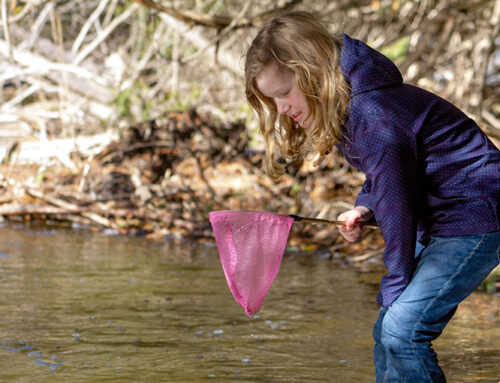
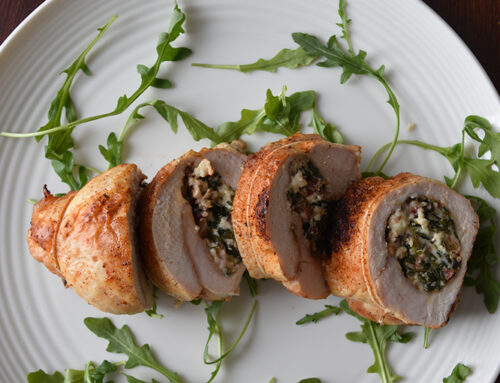
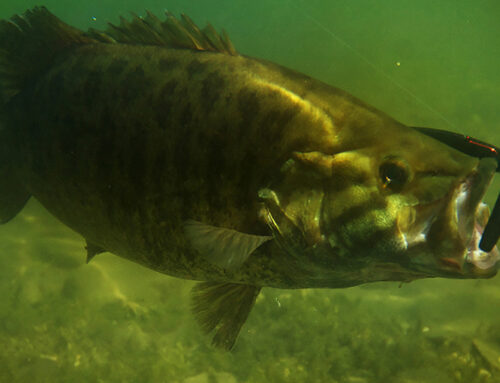
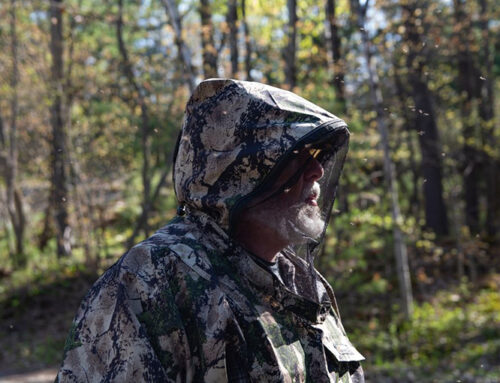
Leave A Comment